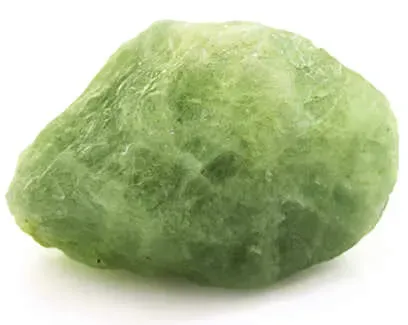 Sphene is a very rare calcium titanium silicate that is hardly ever seen in jewelry or collections. Sphene is also called titanite, which derives from the fact that it is an ore of titanium. The name sphene comes from the Greek word for wedge, which describes the shape of the ends of sphene crystals. Sphene has been prized for many years, mostly for its high amount of fire, however its scarcity always prevented it from becoming well known. Now however, new sources of the stone are being found, and we are starting to see it on the market more often. Most of the sphene we see today comes from Brazil and Madagascar, and some comes from Austria and Switzerland. Sphene is usually very small, as gems of more than two carats are almost impossible to find. The Smithsonian Institution in Washington DC has a collection of yellow sphene from Switzerland, that are arranged in a necklace.
Sphene is a very rare calcium titanium silicate that is hardly ever seen in jewelry or collections. Sphene is also called titanite, which derives from the fact that it is an ore of titanium. The name sphene comes from the Greek word for wedge, which describes the shape of the ends of sphene crystals. Sphene has been prized for many years, mostly for its high amount of fire, however its scarcity always prevented it from becoming well known. Now however, new sources of the stone are being found, and we are starting to see it on the market more often. Most of the sphene we see today comes from Brazil and Madagascar, and some comes from Austria and Switzerland. Sphene is usually very small, as gems of more than two carats are almost impossible to find. The Smithsonian Institution in Washington DC has a collection of yellow sphene from Switzerland, that are arranged in a necklace.
 Sphene is quite unusual and beautiful. It actually has a brilliant fire greater than that of diamonds, however it is soft and fragile, rating only a 5.5 on the hardness scale. Because of its fragility, sphene is never used for rings, however it is suitable for pendants, brooches, and earrings. Sphene is appealing not only because of its fire, but also because of its
Sphene is quite unusual and beautiful. It actually has a brilliant fire greater than that of diamonds, however it is soft and fragile, rating only a 5.5 on the hardness scale. Because of its fragility, sphene is never used for rings, however it is suitable for pendants, brooches, and earrings. Sphene is appealing not only because of its fire, but also because of its ![]() diamond like, adamantine luster, as well as its strong pleochroism, apparent in the colored stones. This pleochroism shows three different colors; colorless, greenish-yellow and brownish yellow. Sphene can be brown, grass green, golden yellow, greenish-yellow, yellow-brown, or sometimes gray or nearly black. Faceted stones have extremely high fire and rich colors. These crystals are often twinned and are best cut as brilliant or mixed cuts, so as to show the crystal's beautiful fire in the best possible way. Sphene is usually transparent to translucent, though occasionally, it can be nearly opaque.
diamond like, adamantine luster, as well as its strong pleochroism, apparent in the colored stones. This pleochroism shows three different colors; colorless, greenish-yellow and brownish yellow. Sphene can be brown, grass green, golden yellow, greenish-yellow, yellow-brown, or sometimes gray or nearly black. Faceted stones have extremely high fire and rich colors. These crystals are often twinned and are best cut as brilliant or mixed cuts, so as to show the crystal's beautiful fire in the best possible way. Sphene is usually transparent to translucent, though occasionally, it can be nearly opaque.
 Sphene is widely distributed as an accessory mineral, particularly in coarse-grained igneous rocks such as syenite, nepheline syenite, diorite and granodiorite. Sphene occurs similarly in cavities in metamorphic rocks such as gneisses, schists, granite, and some metamorphosed limestone. High quality sphene is found in Gilgit, northern Pakistan; the Eifel Mountains, Rhineland-Palatinate, in western Germany; Mount Vesuvius, Naples, in southern Italy; the Kola Peninsula, in northern Russia; Vastmanland, Sweden; Haliburtn County and Hastins County, in Ontario, Canada; and in the United States, around Orange County, New York, and Sussex County, New Jersey. Sphene can also be found in various other locations around Canada, Germany, Italy, Norway, Pakistan, Russia, Sweden, the United Kingdom, the United States, Burma, Austria, Switzerland, Madagascar, Mexico and Brazil.
Sphene is widely distributed as an accessory mineral, particularly in coarse-grained igneous rocks such as syenite, nepheline syenite, diorite and granodiorite. Sphene occurs similarly in cavities in metamorphic rocks such as gneisses, schists, granite, and some metamorphosed limestone. High quality sphene is found in Gilgit, northern Pakistan; the Eifel Mountains, Rhineland-Palatinate, in western Germany; Mount Vesuvius, Naples, in southern Italy; the Kola Peninsula, in northern Russia; Vastmanland, Sweden; Haliburtn County and Hastins County, in Ontario, Canada; and in the United States, around Orange County, New York, and Sussex County, New Jersey. Sphene can also be found in various other locations around Canada, Germany, Italy, Norway, Pakistan, Russia, Sweden, the United Kingdom, the United States, Burma, Austria, Switzerland, Madagascar, Mexico and Brazil.
 Sphene aids the wearer in processing information, as well as in all aspects of improving the mind. It is an excellent aid for debating, theorizing and studying. Sphene also promotes spiritual enlightenment and teaches us to let go of our craving for love. By allowing the wearer to perceive his own greatness, sphene shows us that the more we understand and love ourselves, the less we pine for other people's love.
Sphene aids the wearer in processing information, as well as in all aspects of improving the mind. It is an excellent aid for debating, theorizing and studying. Sphene also promotes spiritual enlightenment and teaches us to let go of our craving for love. By allowing the wearer to perceive his own greatness, sphene shows us that the more we understand and love ourselves, the less we pine for other people's love.